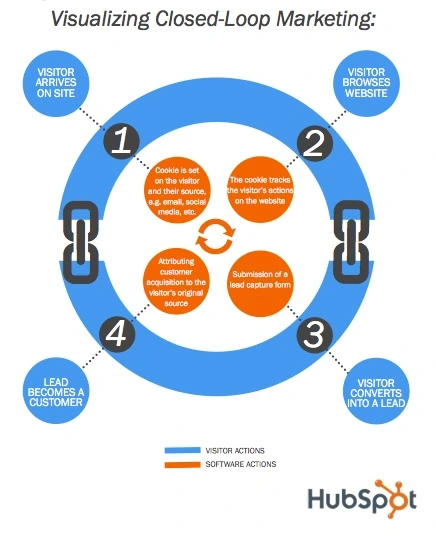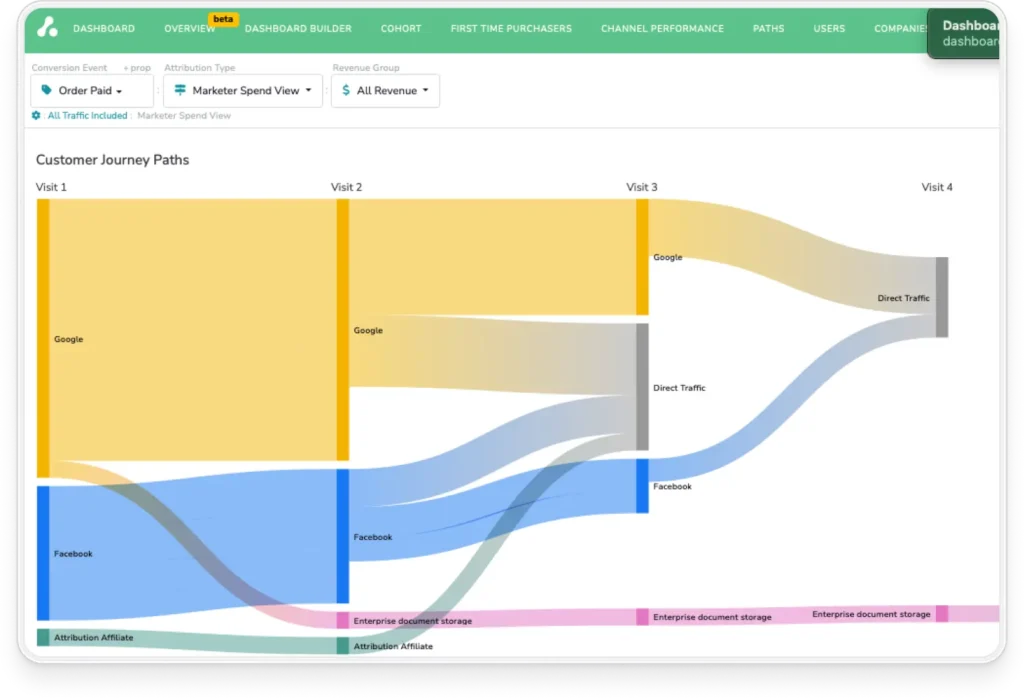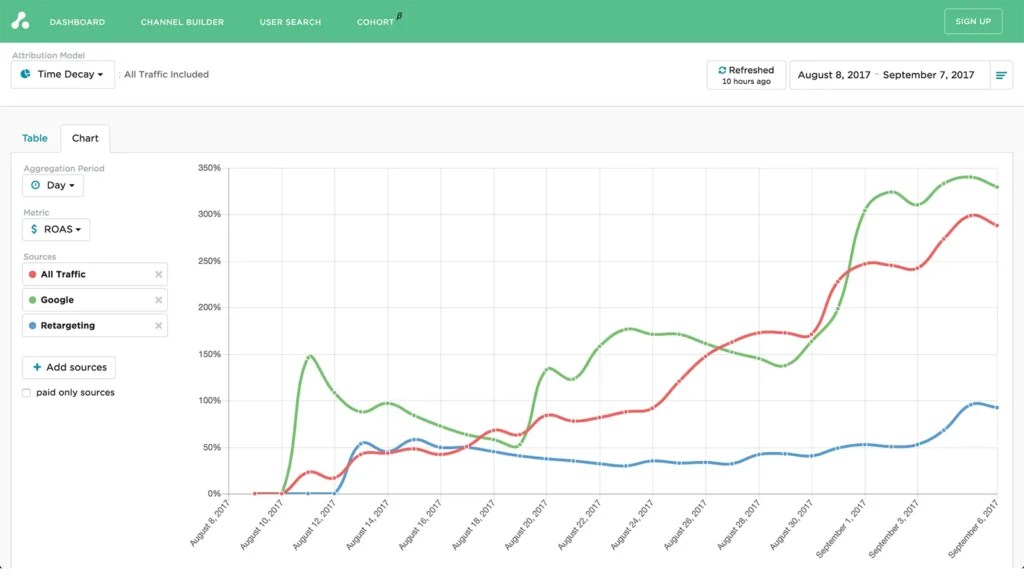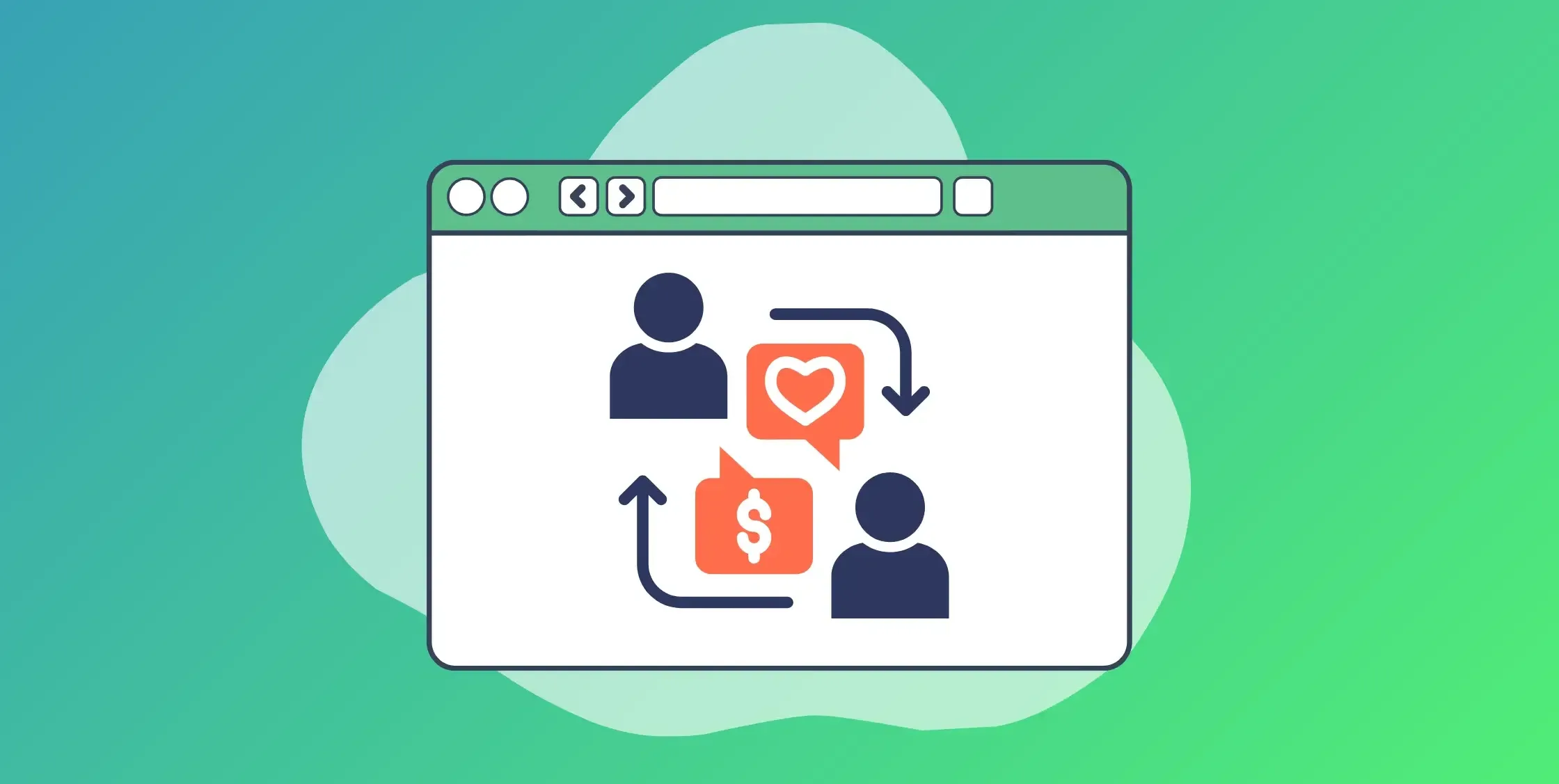Marketers don’t suffer from a lack of data. They suffer from disconnected data. You can measure impressions, clicks, and leads all day, but if you can’t tie those efforts to actual revenue, you’re flying blind when it comes to budget decisions.
This is the fundamental flaw in most attribution setups: they track engagement, not outcomes. And as marketing complexity increases—across channels, devices, and offline interactions—that gap between what’s measurable and what matters keeps growing.
Closed loop attribution solves this by doing what most tools can’t. It links every marketing touchpoint to sales outcomes inside your CRM. It doesn’t just tell you what got clicked. It tells you what got sold, and how to repeat it. When implemented well, it closes the feedback loop between marketing and revenue, making optimization faster, forecasts sharper, and teams aligned around what actually works.
What Is Closed Loop Attribution?
Closed loop attribution is a measurement strategy that connects your marketing data to actual sales outcomes. It works by tying every touchpoint—ads, emails, website visits, and even offline interactions—to closed deals in your CRM. That connection between first click and final sale is what “closes the loop.”
Most attribution models fall short because they stop tracking at lead capture. They’ll tell you how many form fills or demo requests a campaign drove, but not whether those leads converted—or how much revenue they generated. That’s open-loop attribution. It leaves marketers guessing which programs actually deliver business results.
Closed loop attribution fixes that blind spot. By integrating campaign data with CRM and sales systems, it gives marketing teams visibility into what’s driving pipeline, revenue, and return on spend. It’s the difference between optimizing for volume and optimizing for value.
How Closed Loop Attribution Works
Closed loop attribution works by creating a continuous flow of data between your marketing and sales systems—so every campaign, click, and conversion can be tied to real revenue.
This graphic from Hubspot shows the process at a high level.

Here’s how the loop functions step by step:
- A visitor arrives on your site via an ad, email, or social link. A tracking cookie or unique identifier (like GCLID) is applied to capture the source of that visit.
- As the visitor browses, their behavior is logged—pageviews, content downloads, clicks—allowing you to connect early interactions to later outcomes.
- When the visitor converts into a lead, that identifier is captured in your CRM. This is where marketing hands off to sales, but crucially, the source data travels with the lead.
- If the lead becomes a customer, your CRM logs the deal amount, campaign source, and any associated touchpoints. That data is then sent back to your attribution platform.
- The loop closes when revenue data feeds back into your marketing stack. You can now evaluate performance not just by leads generated, but by revenue created.
For this system to work, a few things need to be in place:
- Unique identifiers. Every user journey needs to be traceable from first touch to closed deal. That means reliably capturing campaign parameters, click IDs, or persistent user IDs.
- CRM and sales integration. Without access to opportunity and revenue data, you’re stuck in an open-loop model. Closed loop attribution requires syncing with systems like Salesforce or HubSpot to track deal progression.
- Bi-directional data flow. Campaign data must flow into your CRM, and revenue data must flow back into your attribution engine. This closed feedback loop is what powers real-time optimization and long-term ROI insights.
When these connections are in place, you’re no longer guessing. You’re measuring the actual revenue impact of every marketing decision—and getting smarter with every closed deal.
Book a Demo
Understand the precise impact of each marketing touchpoint and track “true” CAC, ROAS, and ROI on marketing spend with The Attribution Platform.

Strengths and Weaknesses of Closed Loop Attribution
The appeal of closed loop attribution is clear: it gives marketers what most analytics tools don’t—direct visibility into which campaigns actually drive revenue. By linking marketing activity to CRM-recorded sales outcomes, it enables precise ROI measurement that goes beyond vanity metrics.
With that level of clarity, teams can shift from optimizing for lead volume to optimizing for real outcomes. You can calculate customer acquisition cost (CAC) at the campaign level, forecast future revenue based on historical conversion patterns, and reallocate spend in real time based on what’s performing—not just what’s getting clicks. This alignment also brings marketing and sales onto the same page, since both functions are working from a shared set of metrics that reflect actual business impact.
Key strengths include:
- Precise ROI measurement based on closed-won revenue, not just clicks or form fills
- More accurate CAC calculations by channel, campaign, or even creative
- Real-time optimization as revenue data flows back to marketing systems
- Improved marketing-sales alignment through shared visibility into outcomes
- Stronger forecasting driven by historical conversion and revenue data
But while the upside is substantial, implementing closed loop attribution isn’t without its tradeoffs.
For one, the technical lift can be significant. Integrating marketing platforms, ad networks, web analytics, and a CRM—especially across legacy systems or siloed departments—requires clean data and thoughtful architecture. Without identity resolution strategies in place, cross-device journeys can break attribution chains and distort insights. And in environments with long sales cycles, like enterprise B2B, attribution windows may need to span months or even years, complicating how credit is assigned over time.
Key weaknesses and challenges include:
- Data integration complexity, particularly when systems weren’t built to talk to each other
- Attribution window limitations in long B2B sales cycles
- Gaps in cross-device tracking without reliable identifiers
- High setup and maintenance costs, especially for lean teams
- Limited value for top-of-funnel or brand marketing compared to marketing mix modeling
- Insufficient data volume for statistically reliable full funnel attribution in smaller orgs
Still, for teams with the infrastructure to support it, the tradeoff is worth it. Closed loop attribution doesn’t just help you understand what’s working. It helps you stop wasting money on what isn’t.
Best Practices for Implementing Closed Loop Measurement
Closed loop attribution can be a powerful engine for insight, but only when the underlying systems are built with care.
From how data is captured and synced to how models are maintained over time, successful implementation depends on getting a few foundational elements right. The following best practices can help you build a measurement strategy that actually earns trust—and drives decisions.
Ensure Data Hygiene
Attribution only works if the underlying data is clean. When naming conventions are inconsistent, fields go unfilled, or duplicate records pile up, insights become unreliable and trust erodes.
Start by standardizing how campaigns, channels, and content are labeled across systems. Consistent naming ensures that data from ad platforms, marketing automation tools, and your CRM all align. Without a shared taxonomy, reporting quickly becomes fragmented.
It’s also important to run regular audits. Check for missing source fields, malformed UTM parameters, and gaps in the attribution chain. Clean, complete data is what allows attribution models to work effectively.
Duplicates are another common failure point. If the same contact or opportunity appears more than once in your CRM, attribution credit can be split or lost entirely. Use de-duplication tools or set rules to consolidate records and maintain accuracy.
Good attribution depends on governance as much as it does on tooling. Define clear standards for how data should be structured, who’s responsible for maintaining it, and how updates are handled across teams. Without that, even the best platforms will struggle to deliver insight you can trust.
Create Real-Time Revenue Feedback Loops
One of the most valuable outcomes of closed loop attribution is speed. When data flows continuously between marketing and sales systems, you can make decisions while campaigns are still in flight—not weeks after the fact.
The first step is automating your data syncs. Lead and opportunity data should move between platforms like Google Ads, HubSpot, and Salesforce without manual intervention. Tools that support streaming integrations or event-based updates help ensure your dashboards reflect what’s happening in near real time.
To make that feedback actionable, your attribution setup should support:
- Attribution dashboards that update as deals progress, showing metrics like CAC and ROAS in context of pipeline movement
- Automated alerts that flag significant changes in attribution patterns, such as rising costs or shifts in top-performing channels
- Timely revenue data, flowing back into ad platforms to improve algorithmic bidding and segment performance
These systems reduce lag between performance shifts and response. A static weekly report can’t match the responsiveness of a setup that reflects deal-stage changes as they happen.
Real-time feedback isn’t just a reporting upgrade. It’s a strategic advantage. Teams that see performance shifts early can shift budget, adjust creative, and move faster than competitors still waiting on the end-of-quarter summary.
Leverage Machine Learning for Precision
Most rule-based attribution models rely on fixed logic—first touch, last touch, or a predetermined split. While simple to implement, they rarely reflect the true complexity of how customers buy. Machine learning offers a more adaptive, data-driven attribution approach.
By analyzing thousands of conversion paths, AI-powered custom attribution models can detect patterns that would be hard to spot manually. That includes nonlinear journeys, mid-funnel assists, and combinations of touches that correlate with higher deal values or faster close rates.
Rather than assigning arbitrary weights to each interaction, machine learning-powered multi-touch attribution models learn from real outcomes. They evaluate how much each touchpoint contributes to conversions based on historical behavior—not just assumptions. This leads to more accurate credit assignment, especially in long or multi-threaded journeys.
Benefits of algorithmic attribution include:
- More accurate weighting of touchpoints, based on statistical influence rather than predefined rules
- Reduction in human bias, since credit is allocated by observed patterns, not internal politics or gut instinct
- Improved forecasting, with predictive analytics that surface early signals of campaign performance
- Continuous learning, as models adjust in real time to changes in buyer behavior or campaign mix
As attribution models become smarter, they move from descriptive reporting to proactive guidance. Instead of just showing what happened, they start to suggest what to do next.
Maintain Flexibility with Your Data
Attribution isn’t a one-time setup—it’s an evolving system that needs to adapt as your marketing mix changes. Emerging channels like connected TV (CTV), retail media, and audio platforms are becoming part of the modern buyer journey, and your measurement approach needs to account for them.
That starts with having a flexible data architecture. When new platforms or touchpoints enter the mix, your attribution system should be able to ingest and normalize that data without requiring a full rebuild. Rigid tools that only support a fixed set of sources will fall behind as the ecosystem shifts.
API-first platforms make this adaptability possible. They allow you to connect new data sources quickly, plug in third-party enrichments, and evolve your attribution model as your go-to-market strategy matures. Whether it’s a new ad network, offline conversion source, or custom event stream, the system should scale with you.
At the same time, it’s important to balance day-to-day optimization with long-term planning. Attribution should help answer tactical questions—where should we put the next dollar?—but also provide a foundation for more strategic decisions. That includes informing your budget strategy, shaping your channel mix, and forecasting future pipeline.
The goal isn’t just attribution accuracy today. It’s maintaining confidence in your measurement system as your channels, customers, and business priorities continue to evolve.
How the Attribution Platform Closes the Loop

Closed loop attribution only works when your systems are built to support it. That means clean data, real integrations, accurate attribution modeling, and timely feedback. Most marketing teams know what they want to measure. The hard part is operationalizing it in a way that scales—and sticks.
The Attribution platform is purpose-built for this. It connects the full customer journey across systems, assigns credit with machine learning, and gives teams a real-time view of what’s driving revenue.
Here’s how the Attribution Platform makes it possible:
- Unified data infrastructure. The platform automatically pulls in campaign, cost, and engagement data from ad platforms and matches it with lead, opportunity, and revenue data from your CRM. No manual stitching, no siloed reports.
- Native CRM integrations. With direct connections to Salesforce, HubSpot, and other systems, the platform can track every touchpoint from first interaction through closed deal—ensuring attribution is tied to actual outcomes, not just lead volume.
- Machine learning attribution models. Our models analyze conversion paths to determine which touchpoints influence results. This isn’t about evenly splitting credit—it’s about reflecting the true impact of marketing activity based on real historical data.
- Real-time dashboards. Performance data updates continuously as deals progress, so marketers can monitor CAC, ROAS, and revenue contribution at the campaign level—without waiting for a weekly report or end-of-quarter review.
- Online and offline visibility. Whether someone fills out a demo form or attends an in-person event, the Attribution Platform ties the interaction back to pipeline and spend. That means one source of truth for all touchpoints, digital or not.
- Simplified implementation. Instead of building a homegrown solution or managing complex workarounds, the platform gives you a system that’s ready to deploy and designed to grow with you. Its API-first architecture makes it easy to connect new sources, channels, and tools as your stack evolves.
In short, the Attribution Platform doesn’t just support closed loop measurement—it makes it practical. For teams that need a clearer link between marketing investment and business impact, this is the infrastructure that makes attribution work.
Sign up and try Attribution today — pinpoint CAC by channel, audit funnels and conversion rates, scale revenue-driven content marketing, measure affiliate LTV and CAC (and more).

Closed Loop Attribution FAQs
What is the main benefit of closed loop attribution over simpler models?
Closed loop attribution ties marketing activity directly to revenue, not just leads or clicks. This gives you a more accurate view of what’s actually driving business outcomes, so you can make smarter budget decisions and optimize based on real impact—not assumptions.
Is closed loop attribution feasible for smaller businesses or startups?
Yes, especially with platforms like Attribution that streamline implementation. While smaller businesses may have less data volume, even modest pipelines can benefit from clear insight into which channels are generating paying customers—not just traffic.
What if my business relies heavily on offline channels?
Closed loop attribution can incorporate offline touchpoints like phone calls, in-person events, or sales outreach. With proper CRM integration and identifier tracking, those activities can be connected back to marketing sources and included in full-funnel measurement.
How long does it typically take to implement closed loop attribution?
Implementation time varies based on your tech stack and data readiness, but most Attribution Platform customers are up and running in weeks—not months. The platform includes native integrations and automation to simplify setup, even for complex B2B environments.
